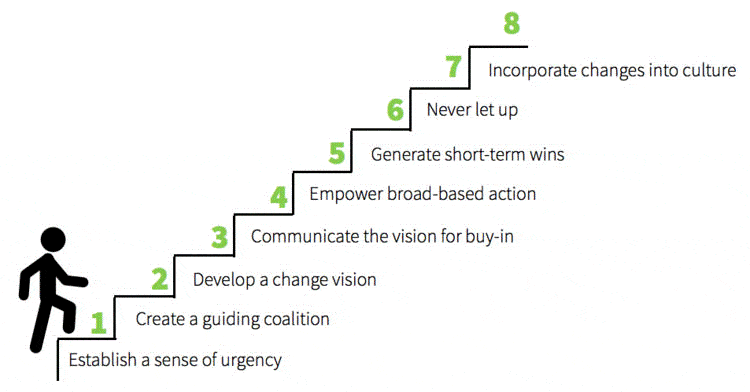Kotter suggests there are eight key steps to successful change management (see stair step picture). After 21 years in a leadership role, I can think of times I’ve applied most all these steps. Number seven, however, is a real struggle. Never let up. As leaders we juggle a number of priorities daily and find ourselves multi-tasking far too often. We may be able to give focused attention to something for a time, but inevitably something else comes in and takes our attention too, and it may be a fire that really needs to be put out. As leaders we delegate and if we are delegating to great managers who almost always follow through on things, it is easy to delegate and move on, forgetting how important it is to circle back and make sure that the new concept we are seeking to embed into culture is really sticking.
A quick reference to each step is summarized here: https://www.leadershipthoughts.com/kotters-8-step-change-model/. Kotter himself shares the steps in his book Leading Change. Kotter has a number of other books on this same subject, joining with Dan S. Cohen on some. Kohen writes a field guide approach here, for those wishing for a more step by step guide to overcoming change obstacles in and organization.
What then can we put in place to make sure we implement step seven until eight becomes the natural result? In many ways the first six steps, if done well, make never letting up much easier. Particularly, creating a guiding coalition (step two) is imperative. This coalition, perhaps your senior leaders, become part of your team of culture changers, with each not letting up. This means a lot of time is spent in those first few steps ensuring buy-in and urgency and vision among this small team, and each of them go forth and don’t let up. Each of them creates their own small group of “converts” who create another group of converts over time. A few tips I’ve found help us as busy, sometimes distracted, leaders stay focused for the long haul:
- Spend a lot of time on the early steps, making sure your coalition or culture changers embrace the exact same vision you do, and that they are able to articulate it to others. Don’t move on to broader buy in or trying to implement the change until this key step happens. Why? This is the period where you are most likely to be clearly focused yourself, and if you can get everyone else on the same page with you, you will have a team who can not only begin the implementation but are less likely to let up when the change is not truly part of the culture yet.
- Make sure the other change managers can effectively communicate the reason behind the change- the value shift that is taking place and what it will improve. This is key to buy-in. This relates to the sense of urgency- the why it is important.
- Create clarity among the team of change managers on how you will measure or know that the culture shift has taken place. Agree together that no one will let up until this measurable change is seen. Then, in order to not become distracted over the long haul, create a clear check-in system that manages you as a leader. It can be as simple as a quick question in each supervision session with one of your change managers, asking where the team member thinks the organization is relative to the end game, or asking him/her to share a short-term win.
- Remember the principles of lean enterprise and continuous improvement. Start with small change. Remember that once you’ve communicated your vision and need for change, that all the solutions you come up with to getting there won’t work. Decide together with your team which one to try first and test it before implementing it organization wide. Make sure your small team knows that failure is ok in the testing mode. One you know if works, celebrate among your small team, then try is boarder scale. If it’s a win, celebrate. When you celebrate, keep reminding everyone of the why behind the change and the value shift you are after.
- Don’t forget that once you have small wins to celebrate, the next step is institutionalizing the change to make it stick. If you move too quickly to a new win and it doesn’t’ tie to and reinforce what you just implemented, the first win will be off track before you finish with your next attempted win. What is needed to make this first win part of the culture?

